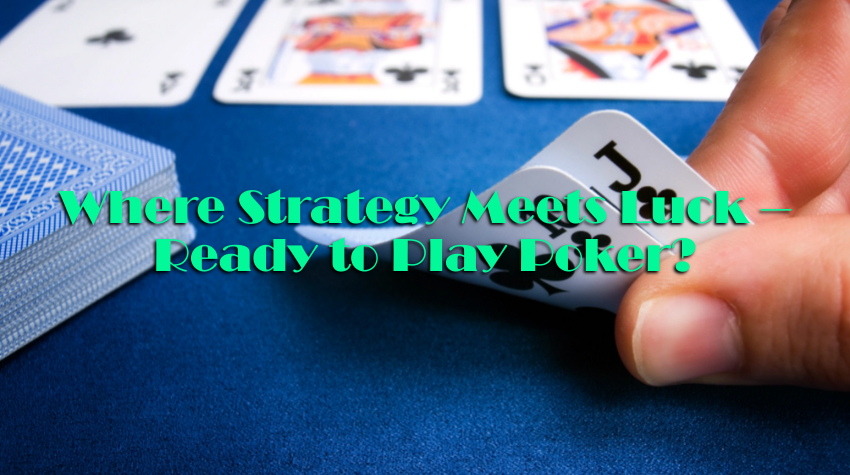Introduction: The New Era of Bluffing in Online Poker
Bluffing is one of the most iconic elements of poker. It’s the moment players imagine when they think of high-stakes tables, dramatic showdowns, and bold moves that force opponents to fold the winning hand. In traditional live poker, a well-timed bluff could change the outcome of a game and build a player’s reputation instantly.
But online poker changed the rules of the game.
With players hidden behind screens, no physical tells to read, and fast-paced, multi-tabling environments, many beginners wonder:
“Does bluffing still work in online poker?”
The short answer:
✅ Yes — bluffing still works, but only when used strategically and with an understanding of online player behavior.
❌ It does not work the same way it does in live poker, and poorly planned bluffs are punished more quickly online.
This guide from Casino Savvy breaks down when bluffing works, when it fails, and how to execute it effectively—even if you’re a beginner. If you’re unfamiliar with the fundamentals of poker itself, it may help to start with this beginner overview:
👉 What Is Poker?
By the end of this article, you’ll understand why bluffing online requires a different mindset, how to adjust your tactics to online environments, and how to bluff smartly, not frequently.
What Is Bluffing in Online Poker?
Bluffing in poker is the strategic act of betting or raising with a weak or average hand to make opponents fold stronger hands. In online poker, bluffing serves the same primary purpose, but the execution differs because players lack physical tells and rely on betting patterns, timing, and stats to detect deception.
Why Players Bluff
Bluffing is used to:
- Win pots you wouldn’t win at showdown
- Apply pressure to opponents
- Build a tight-aggressive (TAG) or balanced table image
- Capitalize on weak or risk-averse players
Bluffing online is less about “acting” and more about understanding data, timing, and psychology.
The Two Core Categories of Bluffs
Bluffs generally fall into two main categories:
1. Pure Bluff
A pure bluff is when you bet with a hand that has no realistic chance of improving.
You rely 100% on fold equity—the probability that your opponent will fold.
Example:
You have 7♣ 2♦ on a board of K♠–10♠–4♥. You fire a bet on the turn, hoping your opponent missed and folds.
2. Semi-Bluff
A semi-bluff is when you bluff with a drawing hand that may become strong if called.
You can still win by improving your hand on later streets.
Example:
You hold A♠ Q♠ on a flop of 9♠–2♠–J♦. Betting here gives two chances to win:
- Opponent folds
- You hit your flush or straight
Semi-bluffs are more effective online as they reduce long-term risk.
Why Bluffing Online Is Harder Than Live Poker
Many beginners try to transfer live table bluffing tactics directly to online poker—and lose quickly.
Online poker introduces unique challenges that make bluffing riskier when misused.
1. No Physical Tells
In live games, bluff-catching often relies on observing body language: trembling hands, breathing patterns, eye contact, facial expressions, or chip-handling behavior.
Online, none of these exist. Players must rely on:
- Bet sizing patterns
- Timing tells
- Player statistics (HUD data if allowed)
- History of hands played
This removes a major advantage skilled bluffers use in physical poker rooms.
2. Faster Gameplay & Multi-Tabling Reduces Emotion-Based Decisions
Online players often multi-table—playing 4, 8, even 12+ tables at the same time.
This leads to decisions made faster, more mechanically, and with less emotional attachment.
Multi-tabling players:
- Don’t think deeply about a single hand
- Fold marginal hands faster
- Call based on math, not instinct
This means some bluffs succeed easily (because multi-tablers don’t waste time hero-calling), but fancy or complicated bluffs fail more often because players rely more on statistics.
3. Player Pool Size and Skill Variation
Online poker has far more players than a physical casino, ranging from beginners to professionals grinding hundreds of hands per hour.
This creates a more unpredictable environment:
- Some players call everything (bad for bluffing)
- Some players fold too much (good for bluffing)
- Some players use advanced tracking software (dangerous to bluff against)
Because of this, bluffing frequency must be adjusted based on table type, stakes, and opponent profiles.
4. Cultural and Regional Playing Styles
Different countries and regions develop different poker “personalities” online.
For example:
- 🇺🇸 US players are more aggressive and bluff-heavy
- 🇪🇺 Europeans balance strategy with GTO-style play
- 🇯🇵 Japanese players (generally) show more patience and prefer value-based play over bluffing
Understanding this helps players from Japan adapt their bluffing strategy against global opponents.
The Key Types of Online Poker Bluffs
Not all bluffs are the same. Some work well in online environments because they rely on math, board texture, and betting patterns, not physical tells. To bluff successfully online, you must understand which type of bluff fits the situation.
Below are the most effective bluff types used by skilled online players.
1. Continuation Bluff (C-Bet Bluff)
A continuation bet (c-bet) is when a player raises pre-flop, misses the flop, but still bets to represent strength.
Why It Works Online:
Because most players assume a pre-flop raiser has strong cards, c-bets often force folds—especially if the flop looks dry.
Example:
You raise pre-flop with A♦ K♣ and the flop is 9♠–4♥–2♣.
Even though you missed, a small c-bet can win the pot immediately.
When to Use:
- Against 1–2 opponents (not multi-way pots)
- On dry boards with few draw possibilities
- When you have a strong pre-flop “story”
2. Semi-Bluff
Semi-bluffing is one of the most profitable bluffing styles online, especially at lower and mid-stakes. You bluff with a hand that can improve.
Example:
Holding Q♠ J♠ on a 10♠–3♣–K♦ board gives you a strong straight draw. A bet applies pressure but also gives you outs if called.
Why It Works Online:
- Adds winning paths
- Protects you from being too predictable
- Reduces long-run risk
Best Spots for Semi-Bluffs:
- When you have draws (flush, straight, overcards)
- In late position
- Against players who fold often to pressure
3. Bluffing With Blockers
A “blocker” is when you hold a card that reduces the chance your opponent has the nuts.
This makes bluffing safer.
Example:
Board: Q♣–10♣–8♣–3♥–2♦
Holding the A♣ blocks many nut flush combos your opponent could have.
Why Blocker Bluffs Work Online:
Online players often think in terms of ranges and probabilities. A blocker bluff reduces the combinations your opponent can continue with, increasing fold equity.
4. The Float Bluff
A float bluff happens when you call on the flop with a weak hand, intending to steal the pot on a later street.
Why It Works:
Many online players c-bet the flop by default but give up on the turn.
You exploit their auto-c-bet tendencies.
Example:
Opponent raises pre-flop and c-bets on a K-7-3 board.
You float with 9-8 suited.
Opponent checks turn → you bet → pot is yours.
5. Overbet Bluff
This occurs when you bet far more than the size of the pot to represent extreme strength.
Purpose:
Force folds from medium-strength hands.
Why It Works Online:
- Online players think mathematically
- Many do not “hero-call” large bets without nuts
Important:
Use selectively. Overbet bluffs work best against tight, thinking players who respect range representation.
6. Polarized River Bluff
A polarized bluff represents either a very strong hand or nothing at all.
Used mostly on the river, where the last betting decision occurs.
Example:
Board runs out: 10♣–10♦–6♠–6♣–A♥
A big river bet here represents full house or trip tens, but you may have only 7-5 suited.
This polarizes your range and pressures opponents holding mid-strength hands.
Which Bluff Should You Choose?
| Bluff Type | Difficulty | Best For | Risk Level |
| C-Bet Bluff | Easy | Beginners | Low |
| Semi-Bluff | Easy–Medium | All players | Low–Medium |
| Float Bluff | Medium | Intermediate players | Medium |
| Blocker Bluff | Medium–Hard | Experienced players | Medium |
| Overbet Bluff | Hard | Advanced players | High |
| Polarized Bluff | Hard | Advanced players | High |
The key is to use the right bluff at the right time, based on opponent tendencies, stack sizes, and board texture.
When Bluffing Works in Online Poker
Bluffing is not a guessing game. Certain conditions significantly increase your chances of a successful bluff.
1. Position Advantage
Bluffs work much better when you are last to act.
Why Position Helps:
- You see your opponents’ moves first
- You control pot size and pressure
- Opponents fear you have more information
Late-position bluffing is one of the highest-EV online poker strategies.
2. Favorable Board Texture
Your bluff is more believable when the community cards support the story you’re telling.
✅ Good Boards for Bluffing
- Dry boards: A-7-2, K-5-5, Q-9-3
- High card boards where you can represent top pair
❌ Bad Boards for Bluffing
- Heavy draw boards: J-10-9 with two suited cards
- Paired boards in multi-way pots
Opponents call more often when the board connects with many potential holdings.
3. Against Tight or Risk-Averse Opponents
Online poker has distinct player archetypes. Bluffing works best against opponents who fold too often.
Signs someone is a good target to bluff:
- Frequently folds to c-bets
- Short time-bank decisions (playing fast and risk-averse)
- Shows very few bluffs at showdown
Avoid bluffing recreational “calling stations” who call with weak hands and hate folding.
4. When Stack Sizes Support Fold Pressure
Stack-to-pot ratio (SPR) decides how much pressure your bluff creates.
- Deep stacks (100bb+) allow multi-street bluffs
- Mid stacks (40–60bb) work well for semi-bluffs
- Short stacks (under 25bb) should rarely bluff
Short stacks have less fold equity—opponents call more often when it costs little to see cards.
5. When You Have Range Advantage
Ask yourself: “Does my range beat theirs more often?”
Example:
As the pre-flop aggressor on an Ace-high flop, you represent the Ace more often than the caller.
This gives you automatic bluffing credibility.
When Bluffing Fails in Online Poker (and Why)
Even skilled players run into situations where their bluff is destined to fail. Knowing when NOT to bluff is equally important as knowing when to execute one.
Below are the most common scenarios that reduce bluff success in online poker.
1. Bluffing Against “Calling Stations”
A calling station is a player who calls frequently with weak or mediocre hands, refusing to fold because they “want to see” your cards.
Signs of a Calling Station:
- Calls your flop, turn, and river bets with bottom or middle pair
- Rarely raises
- Almost never folds to aggression
Why Bluffing Fails:
Your fold equity is nearly zero. Since they don’t fold, bluffing becomes burning chips.
Best Strategy:
Value bet them instead — bet big when you have strong hands.
2. Bluffing in Multi-Way Pots
Bluffs are far less successful with 3 or more players in the pot.
With multiple ranges involved, the chance someone has connected with the board increases dramatically.
Example:
Flop: K♦–10♣–6♠
With three callers, someone likely holds Kx, 10x, or a straight draw.
Rule of Thumb:
Avoid bluffing when more than 2 players see the flop unless the situation strongly favors your range.
3. Excessive Bluff Frequency
If you bluff too often, observant players pick up your pattern quickly—especially online where hand tracking is easier.
Opponents start calling your bets lighter, making bluffs less effective.
Tip:
Good players balance their range:
≈ 70% value bets / 30% bluffs on the river
4. Poor Board Texture for Bluffing
Certain board textures naturally encourage calls.
Bad bluff boards:
- Connected boards: 9-10-J, 8-9-10, Q-J-10
- Double-suited boards with flush draws
- Paired boards (because opponents assume you’re bluffing)
If the story you’re telling doesn’t match the board, opponents won’t believe the bluff.
5. Short-Stack Situations Reduce Fold Equity
When players are short-stacked, they’re more willing to call because they have fewer chips to protect and fewer betting rounds ahead.
Example:
A bluff of 4bb into a 20bb pot may get called because opponents see a cheap chance to win.
Best Practice:
Avoid bluffing below 25bb stacks unless it’s a semi-bluff shove in tournament play.
Essential Skills to Bluff Effectively Online
Bluffing isn’t guesswork — it’s a skill that depends on observation, timing, and execution. Below are the core skills that improve bluff success in online poker.
1. Reading Betting Patterns
Because physical tells don’t exist online, betting patterns are the #1 information source.
Key patterns to observe:
| Pattern | Meaning |
| Small bet = weak hand or cheap bluff | Player may be probing |
| Large instant bet = strong hand or pre-set sizing | Often strength |
| Check-call, check-call, big river bet | Usually a value hand |
| Delayed turn c-bet | Often indicates medium strength hand |
Track how opponents behave on each street — habits repeat online more than live.
2. Range Understanding
Rather than thinking about individual hands, online players think in ranges—the set of possible hands an opponent might hold.
Example:
If an opponent 3-bets from the small blind, their range is often strong:
A-K, A-Q, JJ+, occasionally suited bluffs.
Bluffing works best when your perceived range beats theirs.
3. Using Blockers Smartly
Blockers reduce the combinations of strong hands opponents can have.
Best blocker cards for bluffing:
- Ace blocker (reduces top pair possibilities)
- Suit blocker (reduces flush combos)
- Top straight card blocker (e.g., holding a Q on a J-10-9 board)
Blockers make your bluff mathematically more credible.
4. Bet Sizing for Bluff Success
Your bet size must “tell a believable story.”
Bluff Sizing Guide:
| Street | Recommended Bluff Size | Why |
| Flop | 33–50% pot | Cheap, applies pressure |
| Turn | 50–75% pot | Builds fold equity |
| River | 75–125% pot | Maximum pressure, polarizes your range |
Bet too small and opponents call. Bet too large in the wrong spot and you waste chips.
5. Emotional Discipline
Online poker makes it easy to tilt — especially after a failed bluff.
Rules for emotional discipline:
- Never chase losses with “revenge bluffs”
- Stick to your plan, not your frustration
- Take breaks after big pots
A calm mind bluffs better.
Using Poker Tools to Improve Bluffing Online
Online poker allows players to use software tools to analyze hands and improve bluffing strategy. Note: Some tools are allowed for off-table study only, depending on the poker site.
1. HUDs (Heads-Up Displays)
HUDs track opponent statistics in real time and display them on the table.
Important stats for bluffing decisions:
| HUD Stat | What It Measures | Bluff Usage |
| VPIP | How often they play hands | High VPIP = don’t bluff |
| PFR | How often they raise pre-flop | High PFR = good targets for re-bluffs |
| Fold to C-Bet | How often they fold to flop bets | High % = easy bluff opportunity |
| Aggression Factor | Measures aggression | High AF = may re-bluff you |
HUDs help you choose who to bluff and who to avoid.
2. Hand Review and Tracking Software
Tools like PokerTracker and Hold’em Manager allow players to review hands and assess bluffing performance.
Use them to:
- Study losing bluffs
- Identify bad board choices
- Analyze fold equity in past hands
3. Solvers for Bluff Strategy
Poker solvers (e.g., GTO+ or PioSolver) simulate optimal bluffing frequency based on game theory.
Benefits:
- Teaches balanced strategy
- Reveals optimal bet sizing
- Shows which hands to bluff on which boards
Not necessary for beginners, but very valuable for intermediate to advanced players.
Common Bluffing Mistakes (and How to Avoid Them)
Even experienced players can sabotage their results with poorly timed bluffs. Below are the most frequent errors made in online poker and how to fix them.
1. Bluffing Too Often
Many players think bluffing is the key to winning poker—but over-bluffing makes you predictable.
If opponents realize you bluff frequently, they begin calling more often, turning your bluffs into losing plays.
Fix:
Bluff in balanced, logical spots only, based on board texture and opponent tendencies.
2. Bluffing Weak Players Who Hate Folding
Beginners often bluff “calling stations” because they appear passive.
But these players call frequently due to curiosity or fear of being bluffed.
Fix:
Bluff tight players, not loose ones.
Against calling stations, value bet strong hands instead.
3. Telling an Unbelievable Story
A bluff must logically represent a hand that makes sense based on how you bet.
If your actions don’t match the strong hand you are trying to represent, opponents will call.
Fix:
Before you bluff, ask yourself:
“If I were my opponent, would this bet make sense?”
4. Bluffing Multi-Street Without Commitment
Bluffing one street is easy.
The mistake is betting flop and turn, then quitting on the river because the pot is now “too big.”
This inconsistency signals weakness.
Fix:
If you plan a multi-street bluff, commit to the story before you start.
5. Ignoring Stack Sizes
A bluff that works with a deep stack often fails with a short stack because there isn’t enough pressure to force a fold.
Fix:
Avoid bluffing below 25bb stacks, unless it’s a semi-bluff shove with equity.
Beginner-Friendly Bluffing Strategy (Safe & Effective)
If you’re new to online poker, start with simple, low-risk bluffing techniques that build confidence without losing big chips.
1. Start with C-Bet Bluffs Only
Continuation bets are the easiest bluff for beginners because you naturally represent a strong hand as the pre-flop aggressor.
Beginner Rule:
C-bet the flop only if:
- You raised pre-flop
- Board is dry
- You face 1–2 opponents max
2. Focus on Semi-Bluffs First
Semi-bluffs allow two ways to win:
- Opponent folds
- You hit your draw
This lowers overall risk and improves bluffing judgment.
Hands suitable for semi-bluffs:
- Flush draws
- Open-ended straight draws
- Two overcards with backdoor draws
3. Don’t Bluff Every Session
To avoid becoming predictable, mix your strategy. Some sessions, bluff less. Other sessions, bluff a little more.
Consistency shouldn’t equal repetition.
4. Use Hands with Blockers
If you hold a key card your opponent needs for a strong hand, bluffing becomes safer.
Example:
Holding the A♣ makes it less likely your opponent has the nut flush.
5. Track Bluff Success
After each session, note:
- How many bluffs worked
- Mistakes made
- Opponents who folded too much
This reflection improves your long-term bluffing accuracy.
Advanced Bluffing Strategies for Online Poker
Once you master the basics, these advanced strategies will help increase your win rate at mid and higher-stakes online tables.
1. Polarized Bluffing
On the river, only bluff with hands that have zero showdown value or very strong value hands.
Avoid bluffing with medium-strength hands that can win at showdown.
2. Well-Timed Multi-Street Bluffs
Bluff across flop–turn–river only when conditions support it.
Multi-street bluffs work best when:
- You have a range advantage
- You can represent strong made hands
- Opponent is risk-averse or tight
3. Exploitative Bluffing vs GTO Bluffing
There are two ways to approach bluffing:
| Style | Description | Best For |
| Exploitative | Adjusts your bluff frequency based on opponent mistakes | Low–mid stakes |
| GTO (Game Theory Optimal) | Balanced approach to avoid being exploited | Mid–high stakes |
Beginner → Start exploitative
Intermediate → Blend both
Advanced → Lean GTO to stay un-exploitable
4. Balanced Range Design
If you always bluff with obvious draws, opponents catch on.
Balance your bluffing range by including:
- Missed draws
- Blocker hands
- Rare “surprise” bluffs
This ensures opponents can’t narrow your range easily.
Game Format Impact: Bluffing in Cash Games vs Tournaments vs Zoom
Bluffing success varies based on the game format. Understanding the difference helps adjust strategy effectively.
1. Cash Games
- Players are deeper stacked
- More post-flop play
- Bluffs must be well-planned and credible
Cash game opponents take notes, use HUDs, and remember your tendencies. Be more balanced.
2. Tournaments
Bluffing becomes more powerful due to ICM pressure.
Best times to bluff in tournaments:
- Near the bubble
- When covering smaller stacks
- Against players trying to ladder up
Short stacks are more likely to call all-ins → avoid bluff-shoves without equity.
3. Zoom / Fast-Fold Poker
Zoom poker moves rapidly. Players fold more frequently to wait for premium hands.
This increases bluff profitability, especially from late position.
However:
- Harder to build table image
- Requires mathematical and range-based bluffing rather than psychological bluffing
So, Is Bluffing Still Worth It in 2025 Online Poker?
Yes — but with caution and strategy.
Bluffing online remains a profitable tactic, but only when used:
- Selectively
- Logically
- Based on player type and board texture
Modern online poker rewards players who bluff smart, not often.
With player tracking, fast play, and solver-influenced strategies, bluffing has evolved from an emotional tactic to a data-driven skill.
Conclusion: Bluffing Still Works — If You Use It Wisely

\ Where Strategy Meets Luck – Ready to Play Poker? /
Bluffing is still a core part of winning online poker, but it requires more discipline, timing, and logic than it did in traditional live settings. The key is not to bluff more—but to bluff better.
Successful online bluffing requires:
- Choosing the right opponents
- Understanding board texture and position
- Mixing value and bluff hands for balance
As you continue learning the game, remember that bluffing is only one piece of a complete poker strategy. Practice, review your hands, and improve step-by-step.
For more guides and strategies designed specifically for online players in Japan, visit Casino Savvy, your trusted source for casino tips, game guides, and player-friendly learning:
https://free-gamblings.com/









Comments